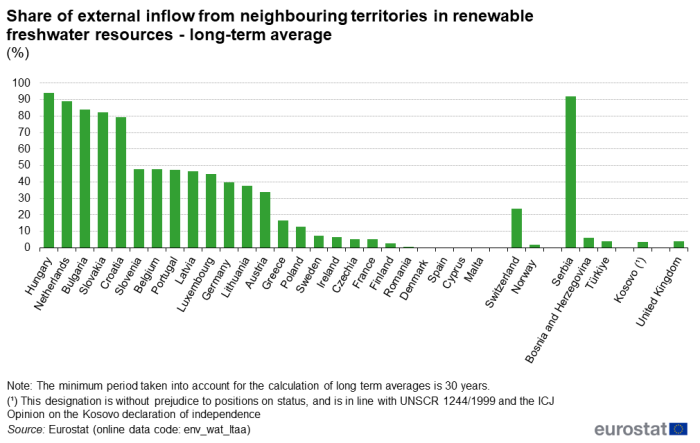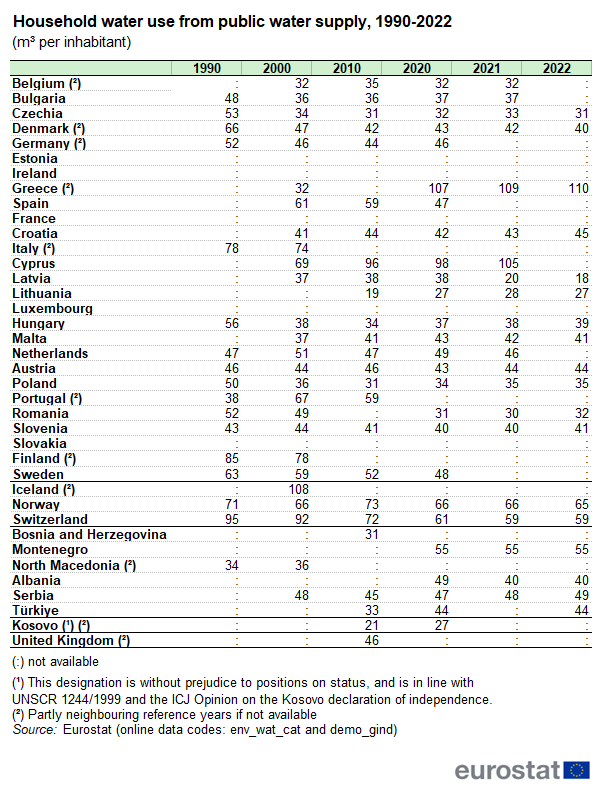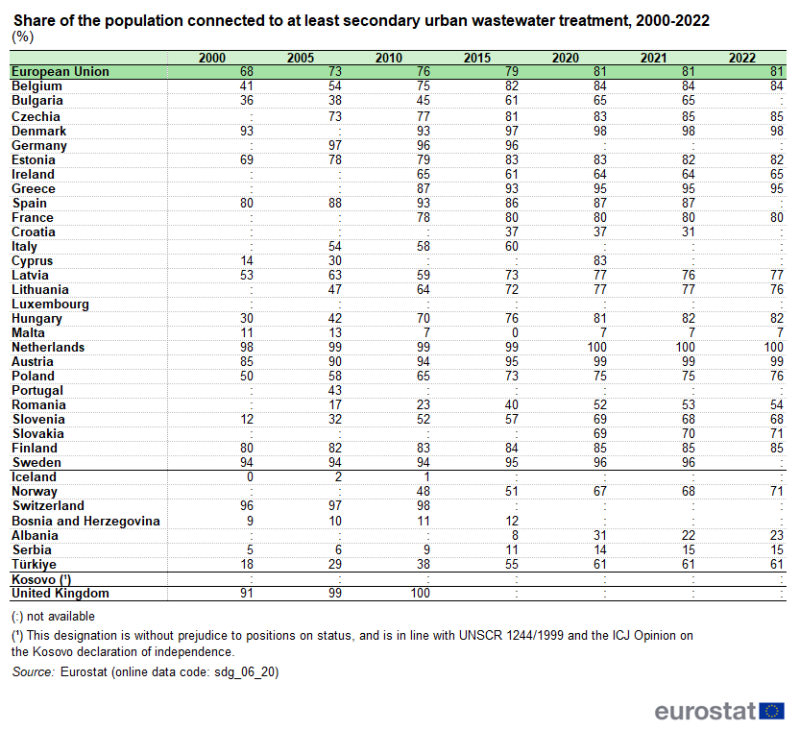Data extracted in July 2024
Planned article update: July 2025
Highlights
Among the EU countries, Croatia recorded the highest renewable freshwater resources (with a long-term average of 30 700 m³ per inhabitant), followed by Finland (19 800 m³), Latvia (19 500 m³) and Sweden (18 600 m³).
Over the last decades, an increasing share of the population is being connected to wastewater treatment.
Share of external inflow from neighbouring territories in renewable freshwater resources - long-term average
Water is essential for life, it is an indispensable resource for the economy, and also plays a fundamental role in the climate regulation cycle. The management and protection of water resources, of fresh and salt water ecosystems, and of the water we drink and bathe in is therefore one of the cornerstones of environmental protection. This is why the EU's water policy over the past 30 years is focused on the protection of water resources, ensuring that good quality water, in sufficient quantity, is available for all legitimate uses. The state of play is described by the fifth implementation report (2019) of the Water Framework Directive (2000), the central piece of environmental legislation concerning European waters. Recent insight about the quality of existing water related EU legislation and perspectives for its future development is offered by the Fitness check of the Water Framework Directive and related legislation (2019).
This article presents water statistics in the European Union (EU). It is based on data on freshwater resources, water abstraction, water use and wastewater treatment and disposal.
Water as a resource
Water resources refer to the freshwater available for use in a territory and include surface waters (lakes, rivers and streams) and groundwater. Renewable water resources are calculated as the sum of internal flow (which is precipitation minus actual evapotranspiration) and external inflow. Freshwater availability in a country is primarily determined by climate conditions and transboundary water flows (in other words, external inflows), while for total amounts, the size of the country matters. Freshwater resources per inhabitant are considered an important indicator for measuring the sustainability of water resources. For EU Member States, the average water resources are about 4-5 thousand m³ per inhabitant. In water-rich countries an inhabitant's share can be as high as around 30 thousand m³ (Croatia) or close to 70 thousand m³ as in Norway. According to the World water development report of the United Nations, a country experiences 'water stress' when its annual water resources are below 1 700 m³ per inhabitant; among the EU Member States, this is the case in Poland, Czechia, Cyprus and Malta.

(million m³)
Source: Eurostat (env_wat_ltaa) (demo_gind)
A number of countries receive a significant proportion of their renewable freshwater resources as external inflow (see Figure 1). Among the EU Member States, there are five countries with ca. 80% and more dependency on transboundary water resources.

(%)
Source: Eurostat (env_wat_ltaa)
Water uses
The overall use of water resources can be considered sustainable in the long-term in most of Europe. However, specific regions may face problems associated with water scarcity; this is the case particularly in parts of southern Europe, where it is likely that efficiency gains in agricultural water use (as well as other uses) will need to be achieved in order to prevent seasonal water shortages. Regions associated with low rainfall, high population density, or intensive agricultural or industrial activity may also face sustainability issues in the coming years, which could be exacerbated by climate change impacts on water availability and water management practices.
Water is provided either by public water supply (public or private systems with public access) or is self-supplied (for example, private drills). While the share of the public water supply sector in total water abstraction depends on the economic structure of a given country and can be relatively small, it is nevertheless often the focus of public interest, as it comprises the water volumes that are directly used by the population.
Table 2 presents households' water use from public supply. It varies across European countries - the median is around 40-50 cubic metres per inhabitant and has been slightly decreasing over the last decades.

(m³ per inhabitant)
Source: Eurostat (env_wat_ltaa) (demo_gind)
Wastewater treatment and disposal
Overall, there is a development towards a higher proportion of the population being connected to wastewater treatment. Table 3 presents information on the proportion of the population connected to at least secondary wastewater treatment plants, which typically is an acceptable level of environmental protection unless the receiving waters are in a sensitive area. This share has been generally increasing over the past decades and was above 80% in half of the EU Member States for which recent data are available (mixed reference years). The share of the population connected to at least secondary wastewater treatment plant even rose to 95% and above in six Member States (Denmark, Germany, Greece, the Netherlands, Austria and Sweden), as well as Switzerland and the United Kingdom. At the other end of the range, less than one in two households were connected to at least secondary urban wastewater treatment plants only in Malta and Croatia, while the same was also true in Iceland, Albania, Serbia, and Bosnia and Herzegovina.

(%)
Source: Eurostat (sdg_06_20)
Source data for tables and graphs
Data sources
Water statistics are collected through the joint OECD/Eurostat questionnaire on inland waters, which is an established data collection yielding long time series. However, data collection is on a voluntary basis, which leads to considerable data gaps. The joint questionnaire on inland waters includes the following characteristics:
- freshwater resources in groundwater and surface water — these can be replenished by precipitation and external inflow (water flowing into a country from other territories);
- water abstraction — a major pressure on resources, although a large part of the water abstracted for domestic, industrial (including energy production) or agricultural use may be returned to the environment and its water bodies (although often as wastewater with impaired quality);
- water use — analysed by supply category and by industrial activities;
- the share of the population connected to wastewater treatment plants — which gives an overview of the development status of the infrastructure, in terms of quantity and quality, that is available for the protection of the environment from pollution by wastewater;
- sewage sludge production and disposal — an inevitable product of wastewater treatment processes, its impact on the environment depends on the methods chosen for its processing and disposal;
- generation and discharge of wastewater — pollutants present in wastewater have different source profiles and, similarly, the efficiency of treatment of any pollutant varies according to the method applied [1].
In general, Eurostat collects national data. Some of the characteristics above are also collected at the level of river basin districts by means of a regional questionnaire.
A large amount of data and other information on water is accessible via WISE, the water information system for Europe, which is hosted by the European Environment Agency (EEA) in Copenhagen.
Context
Water policies: floods, droughts and other challenges
The central element of European water policy is a Directive for 'Community action in the field of water policy' (2000/60/EC) — often referred to as the Water Framework Directive (WFD) — which aims to achieve a good ecological and chemical status of European waters. Together with its daughter legislation (Directive 0118/2006 and Directive 0060/2007), the WFD focused on water management at the level of (in most cases transboundary) hydrological catchments (river basins). An important step in the course of its implementation involved establishing river basin management plans. The latest state of play is summarised in the Commission's implementation report of February 2019 (COM(2019) 95 final).
In a Communication 'Addressing the challenge of water scarcity and droughts' (COM(2007) 414 final), the European Commission identified an initial set of policy options to be taken regionally, nationally and across the EU to address water scarcity within the EU. This set of proposed policies, which was reviewed and further developed by 2012, aimed to move the EU towards a water-efficient and water-saving economy, as both the quality and availability of water are considered as major concern in many regions.
In a Fitness check of the EU Water Framework Directive and related legislation (2019), the Commission identified strengths and weaknesses of the existing legislation and explored the need for possible amendments.
Wastewater
In an effort to reduce pollutants discharged into the environment with wastewater, the EU has implemented legislation on urban wastewater treatment (Directive 1991/271/EC). The pollution of rivers, lakes and groundwater and water quality is affected by human activities such as industrial production, household discharges, or arable farming; a report on the protection of waters against pollution by nitrates from agricultural sources (COM(2007) 120 final) was released in March 2007.
Another aspect of water quality relates to coastal bathing waters. The European Commission and the EEA present an annual bathing water report. The latest of these always covers information of the preceding year and shows that more than 95% of the EU's bathing waters met the minimum water quality standards.
Blueprint to safeguard Europe's water resources
These policy perspectives up to 2050 were developed in the 'Blueprint to safeguard Europe's water resources' (COM/2012/0673) which integrates the results of a policy review concerning: water scarcity and droughts; an analysis of the implementation of river basin management under the WFD; a review of the vulnerability of environmental resources (such as water, biodiversity and soil) to climate change impacts and man-made pressures; and a review of the whole of the EU's water policy framework in the light of the European Commission's 'better regulation' approach. The blueprint is closely related to the Resource efficiency roadmap (COM(2011) 571). However, the blueprint covers a longer time span, through to 2050, and is expected to drive EU water policy over the long term. As part of the blueprint there are a number of policy reviews assessing implementation.
Notes
- ↑ Discharges from cooling water are not regarded as wastewater in water statistics.
Explore further
Other articles
Database
Thematic section
Selected datasets
Methodology
- Water statistics on national level (ESMS metadata file — env_nwat_esms)
External links
Legislation
- The Water Framework Directive Directive 0060/2000, central piece of European water-related legislation
- Summaries of EU legislation: Good-quality water in Europe (EU Water Directive)
- Report on the implementation of the Water Framework Directive (2000/60/EC) and the Floods Directive (2007/60/EC) - Second River Basin Management Plans, First Flood Risk Management Plans COM(2019) 95 final
- Communication 'A blueprint to safeguard Europe's water resources' (COM(2012) 673 final)
- Summaries of EU legislation: EU water resources protection plan
- Communication 'Addressing the challenge of water scarcity and droughts in the European Union' (COM(2007) 414 final)
- Summaries of EU legislation: Addressing water scarcity and droughts in the EU
- Directive 2007/60/EC of 23 October 2007 on the assessment and management of flood risks
- Summaries of EU legislation: Flood-risk management in the EU
- Directive 2006/118/EC of 12 December 2006 on the protection of groundwater against pollution and deterioration
- Summaries of EU legislation: Protection of groundwater against pollution
- Directive 91/271/EEC of 1 May 1991 concerning urban wastewater treatment
- Summaries of EU legislation: Urban waste water treatment
